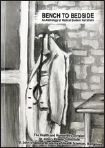Translate this page into:
Bench to Bedside: An anthology of medical student narratives
Corresponding Author:
Sunil K Pandya
Flat 11, 5th floor, Shanti Kutir, Netaji Subhash Road (Marine Drive), Mumbai, Maharashtra
India
shunil3@gmail.com
| How to cite this article: Pandya SK. Bench to Bedside: An anthology of medical student narratives. Natl Med J India 2018;31:313 |
Bench to Bedside: An anthology of medical student narratives. Timms Olinda (ed). The Health and Humanities Division, St John’s National Academy of Health Sciences, Bengaluru, Karnataka, 2017. 84pp, price not mentioned.

A separate building in the campus of the St John’s Academy in Bengaluru houses the Department of History of Medicine on the ground and first floors. The department, named after its erstwhile Professor of History of Medicine and munificent donor, Major General S.L. Bhatia, is attracting national and international scholars. Dr Mario Vaz heads it.
The Division of the Humanities and Health is housed on the second floor of this building and is headed by Dr Manjulika Vaz—Dr Mario’s better 9/10th. It is also fortunate in having Dr Olinda Timms as an associate. Dr Timms is the author of an excellent text on medical ethics in the Indian context.
We learn that the book under review is the outcome of a project set up by two persons. Dr Kavery Nambisan is an alumnus of the college and now a rural surgeon with two works of fiction to her credit. She drew up the project with Ms Sridala Swami, a poet and author. Although she writes for children, Ms Swami has also written on death, decay that accompanies ageing and the fragile nature of relationships. Together with Dr Manjulika Vaz, they organized a workshop on creative writing and communication. They encouraged medical students to embark ‘on a journey of writing reflective narratives’. This book contains the essays, poems and illustrations that flowed out of the impressionable youngsters.
The five sections of the book contain accounts of personal experiences, emotions and thoughts as the students travel through the 4 years of medical school and into internship. We are acquainted with the authors through their photographic portraits and learn a little about their aptitudes in notes provided at the end of each contribution. Drawings and a few photographs by fellow-students illustrate the book. Two narratives have been selected from the offerings of four students and one each from the remaining 12 students. A first-year student has designed the cover.
It is obvious that these talented youngsters are already steeped in the humanities. Ms Aiswarya Sasi provides the first two offerings in the form of a poem and a rambling account. We learn that she is also a Carnatic vocalist. Ms Tia Thomas, Ms Elaina Pasangha and Ms Sitarah Mathias are pianists. Ms Divya Devaraj loves dancing and theatre. Mr Kamal Jain has provided the illustration for his own essay. Ms Helena Makri dreams of setting up a hospital in the Ri Bhoi district of Meghalaya along with a Bistro kitchen for those with a sensitive palate! When you study this anthology, do not miss Ms Makri’s ‘The great book story’. Your admiration for her will deepen.
The insights provided in their contributions are thought-provoking. Here are some vignettes.
Ms Sasi tells us that as she embarked on her first anatomy dissection, she was struck by the profound realization that she had seen more of her subject than he had ever done himself. Elaina Pasangha, on the other hand, holding the brain she had just removed from the skull, felt, ‘All his memories, his hopes and dreams, the things he liked, the things he hated. I held what made him who he was, in the palm of my hand.'
Mr Denver Hurtis puts the importance of medical textbooks (the weight of some can put construction bricks to shame) in perspective as he evaluates the information in them against what we learn from the experiences of our teachers and from our own patients (p. 27).
‘I knew he would be okay if I called you,' a sobbing 10-year-old child kept saying to Ms Deign Maria John in relief. Ms John, a second-year student, had rushed to the aid of the child’s father who had collapsed after a syncope. This heart-felt evidence of trust humbled her.
Finally, consider Ms Tia Thomas’ feelings as she saw a young girl who had suffered burns all over her body. As the patient’s medical attendants cleaned her wounds, ‘she started weeping. The tears that ran down her cheeks must have caused even more pain because her cheeks had no skin. She writhed in pain…'
Dr Timms captures the essence of this book in her Note from the editor : ‘Any medical professional will empathize with the angst and resilience that resonates through these narratives.'
Her note ends thus: ‘I hope this effort will encourage more young doctors to share reflections from their lived experiences in a profession that is rich with triumphs, frustrations, learning, encounters, hope and humanity.'
Amen!
Fulltext Views
2,000
PDF downloads
1,449




